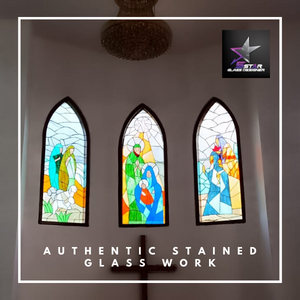Exploring Art of Designing Stained Glass and Decorated Glass Work
Glass windows have been a fundamental element of architectural design for centuries. From the intricate stained glass windows adorning medieval cathedrals to the contemporary marvels of decorated glass work in modern structures, these elements are more than just functional; they are a canvas for artistic expression. In this article, we will delve into the captivating world of design in glass windows, exploring the beauty of stained glass design work and the allure of decorated glass work.

Stained Glass Design Work
Stained glass design work is a timeless art form that has graced the walls of churches, cathedrals, and even homes for over a millennium. The process begins with the selection of colored glass pieces, each carefully chosen for its hue, transparency, and texture. These pieces are then cut into various shapes, a meticulous task that requires precision and skill.
The magic happens when these pieces are assembled like a jigsaw puzzle to form a larger image or pattern. Lead strips, known as cames, are used to hold the glass pieces together, and once the design is complete, the entire panel is soldered for strength and durability. The result is a stunning work of art that captures and diffuses light in mesmerizing ways, casting a kaleidoscope of colors and patterns into the surrounding space.
Decorated Glass Work
Decorated glass work, on the other hand, encompasses a broader spectrum of design possibilities. It includes techniques such as etching, engraving, and fusing, allowing artists to create intricate patterns, textures, and even three-dimensional effects on glass surfaces. This form of glasswork is not limited to windows; it is also used in doors, partitions, and decorative elements within interiors.
One of the most enchanting aspects of decorated glass work is its versatility. Artists can manipulate glass to mimic various materials, such as wood, metal, or even fabric, opening up a world of creative possibilities. The play of light and shadow on textured or layered glass surfaces adds depth and intrigue to any architectural space.

The Intersection of Form and Function
Both stained glass design work and decorated glass work demonstrate the intersection of form and function. While they serve practical purposes like providing natural light and privacy, these glass elements elevate the aesthetics of a building, turning it into a work of art.
The design of glass windows has evolved over the centuries, from the awe-inspiring stained glass windows of ancient cathedrals to the contemporary marvels of decorated glass work in today's architectural landscape. These windows are not just openings to the outside world; they are canvases that showcase the boundless creativity and craftsmanship of artisans. As we continue to push the boundaries of design and technology, one thing remains constant: the timeless allure of glass as a medium for artistic expression.
Comments
Post a Comment